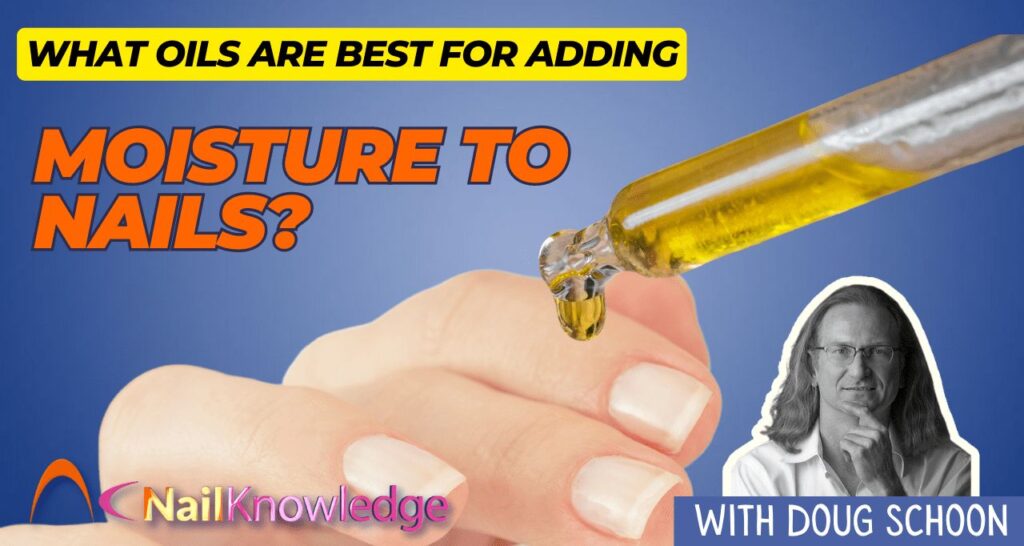Ngoài ra, các loại dầu khác nhau có tốt hơn cho tóc hay da không?
Moisturizers are misunderstood. Contrary to what some may believe, oils can’t add any moisture to nails, skin or hair, but they can prevent “dryness”, so this causes some confusion.
Vai trò của việc giữ ẩm và cô đặc nước
When moisturizing is added, that increases “water” concentration inside nails, skin or hair. As you probably already know, water and oil don’t mix.
Bản chất khan của dầu mỹ phẩm và chất nhũ hóa
The water content of any cosmetic oil is nearly zero. They are considered “anhydrous” or “without water”. Oils and water can exist together in a cosmetic lotion or cream, but only if they are mixed with a special type of ingredient called an “emulsifier”. Emulsifiers are used to create many types of oil and water blends. Many foods, such as salad dressings, mayonnaise and ice cream are all made possible by emulsifiers and without them, these ingredients would quickly separate.
Độ ẩm và kem/lotion
Kem và sữa dưỡng thể có thể làm tăng độ ẩm của móng tay, da hoặc tóc vì chúng có chứa một lượng lớn nước. Bản thân dầu cũng có thể làm tăng độ ẩm content of nails and skin, but they do this in a different way than many understand. Oils coat the nails and skin with a thin film that forms a moisture resistant barrier.
Dầu và tác động của chúng đến hàm lượng ẩm
Some oils can penetrate and will create a barrier in the upper layers of the skin. Underneath this barrier, moisture can build up, thus raising the water content of nails or skin, but not for hair. Why? A steady supply of water travels from the nail bed to the nail plate surface, just as it does from the dermis to the skin’s outer surface.
Di cư nước và TEWL
This water migration is slowed down by oils. Water migration through the epidermis is called “trans-epidermal water loss” or TEWL. Cosmetic scientists use special instruments to measure the TEWL to determine the effectiveness of skin lotions, creams and oils. Lower water loss (less water escaping from the skin) means a product is a more effective moisturizer.
Oils’ Effects on Nails, Skin, and Hair
This type of water migration doesn’t occur in a shaft of hair, so oils can’t moisturize the hair. Some oils provide additional benefits by increasing the flexibility in nails, skin or hair. As I explained in a previous question, nail oils add lubrication which allows the various layers to slide across each other, increasing flexibility. Oils also soften each of these to make their surfaces less hard. Some don’t penetrate at all, and remain on top of the skin. Those that sit on top of the skin are called “occlusive agents”.
Chất gây tắc nghẽn và giữ ẩm
That term may sound like something out of a spy thriller, but the word “occlude” simply means “to block” or “obstruct”. Mineral oil is an “occlusive agent” which means it doesn’t penetrate; instead, it will sit on the skin to create a barrier that slows or blocks moisture evaporation.
Dầu silicon cũng có thể là tác nhân gây tắc nghẽn.
Tăng độ ẩm và làm căng da
The same type of moisture build-up would occur if you wrapped the skin in plastic wraps that keep foods fresh in the refrigerator. Occluding the skin causes moisture build-up, but we wouldn’t think of these plastic wraps as a skin moisturizer, even though they increase the level of moisture in the skin.
Hàm lượng nước tăng cũng có thể có chức năng làm mềm và cải thiện độ đàn hồi của da và cũng có thể gây ra tình trạng đầy đặn. Tất nhiên, điều tương tự cũng xảy ra ở móng tay, nhưng ở mức độ thấp hơn và ngược lại cũng xảy ra.
Dầu và ngăn chặn sự thâm nhập quá mức của nước
Dầu cũng có thể ngăn chặn sự xâm nhập của lượng nước dư thừa từ bên ngoài vào móng tay, tóc hoặc da và ngăn chúng bị bão hòa quá mức với các phân tử nước.
Phần kết luận
Hiểu được vai trò của dầu trong việc dưỡng ẩm là rất quan trọng để duy trì móng tay, da và tóc khỏe mạnh. Mặc dù bản thân dầu không thể bổ sung độ ẩm, nhưng chúng đóng vai trò quan trọng trong việc ngăn ngừa khô da bằng cách tạo ra một hàng rào bảo vệ. Các loại dầu khác nhau về khả năng thẩm thấu và tạo ra hàng rào, một số loại dầu mang lại những lợi ích bổ sung như tăng độ đàn hồi.
It’s important to note that water and oil do not mix, and the water content of cosmetic oils is minimal. Creams and lotions, on the other hand, contain significant amounts of water, making them effective at increasing moisture content.
Furthermore, the concept of occlusive agents, such as mineral oil and silicone oils, should be understood. These agents form a barrier on the skin’s surface, slowing down moisture evaporation and enhancing softness and plumping effects. However, they should not be mistaken for traditional moisturizers.
Bằng cách nắm bắt sự khác biệt giữa dầu, kem và chất làm tắc nghẽn, chúng ta có thể đưa ra lựa chọn sáng suốt về các sản phẩm tốt nhất để hỗ trợ sức khỏe móng, da và tóc của mình. Hãy nhớ xem xét các đặc tính riêng biệt của từng loại và lựa chọn phù hợp để duy trì độ ẩm tối ưu và sức khỏe tổng thể.
Câu hỏi thường gặp
- Dầu có thể bổ sung độ ẩm cho móng tay, da hoặc tóc không?
Không, dầu không thể bổ sung độ ẩm cho móng, da hoặc tóc. Tuy nhiên, chúng có thể ngăn ngừa khô da bằng cách tạo thành một lớp màng giữ độ ẩm. - Liệu các loại dầu khác nhau có thể có tác dụng khác nhau lên da và tóc không?
Có, các loại dầu khác nhau có thể có tác dụng khác nhau lên da so với tóc. Trong khi dầu có thể làm tăng độ ẩm và mang lại lợi ích cho móng và da, chúng không có tác dụng dưỡng ẩm tương tự lên tóc. - Chất gây tắc nghẽn là gì và chúng ảnh hưởng đến khả năng giữ ẩm như thế nào?
Occlusive agents are substances that create a barrier on the skin’s surface, preventing moisture evaporation. Examples include mineral oil and silicone oils. They can help retain moisture and improve skin flexibility, but they should not be confused with traditional skin moisturizers.


